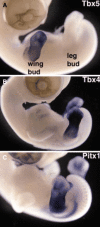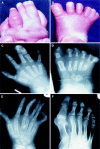Genetic regulation of embryological limb development with relation to congenital limb deformity in humans
- PMID: 19308596
- PMCID: PMC2656784
- DOI: 10.1007/s11832-008-0076-2
Genetic regulation of embryological limb development with relation to congenital limb deformity in humans
Abstract
Over the last 15 years, great improvements in genetic engineering and genetic manipulation strategies have led to significant advances in the understanding of the genetics governing embryological limb development. This field of science continues to develop, and the complex genetic interactions and signalling pathways are still not fully understood. In this review we will discuss the roles of the principle genes involved in the three-dimensional patterning of the developing limb and will discuss how errors in these signalling cascades correlate to congenital limb deformity in humans. This review is aimed at orthopaedic surgeons wishing to understand the principles of congenital limb deformity related to genetic signalling errors. It is by no means a comprehensive study of the molecular genetics governing the complex interactions involved in each step of limb development. There are however many syndromes involving limb deformity for which the molecular causes are unknown.
Figures





Similar articles
-
Patterning the limb before and after SHH signalling.J Anat. 2003 Jan;202(1):3-12. doi: 10.1046/j.1469-7580.2003.00138.x. J Anat. 2003. PMID: 12587914 Free PMC article. Review.
-
Congenital limb deficiencies.Ann Acad Med Singap. 1981 Oct;10(4):524-43. Ann Acad Med Singap. 1981. PMID: 7344582
-
[Genetics and orthopedics: genetic implications of congenital limb abnormalities].Rev Chir Orthop Reparatrice Appar Mot. 2006 Feb;92(1):83-94. doi: 10.1016/s0035-1040(06)75680-x. Rev Chir Orthop Reparatrice Appar Mot. 2006. PMID: 16609623 Review. French.
-
[CHARACTERISTICS AND TRENDS OF CONGENITAL AND ACQUIRED LOWER LIMB DEFICIENCY IN CHILDREN AND ADOLESCENTS AT THE SHEBA MEDICAL CENTER].Harefuah. 2018 Aug;157(8):511-516. Harefuah. 2018. PMID: 30175567 Hebrew.
-
Complete cleft of the upper limb: A very rare anomaly.Indian J Plast Surg. 2008 Jul;41(2):195-9. doi: 10.4103/0970-0358.44842. Indian J Plast Surg. 2008. PMID: 19753263 Free PMC article.
Cited by
-
Ultrasound Imaging Reveals Accelerated In-utero Development of a Sensory Apparatus in Echolocating Bats.Sci Rep. 2019 Mar 27;9(1):5275. doi: 10.1038/s41598-019-41715-y. Sci Rep. 2019. PMID: 30918299 Free PMC article.
-
Variants in KIAA0825 underlie autosomal recessive postaxial polydactyly.Hum Genet. 2019 Jun;138(6):593-600. doi: 10.1007/s00439-019-02000-0. Epub 2019 Apr 13. Hum Genet. 2019. PMID: 30982135 Free PMC article.
-
Maternal periconceptional exposure to cigarette smoking and congenital limb deficiencies.Paediatr Perinat Epidemiol. 2013 Nov;27(6):509-20. doi: 10.1111/ppe.12075. Epub 2013 Jul 31. Paediatr Perinat Epidemiol. 2013. PMID: 24134526 Free PMC article.
-
Patients with Congenital Limb Anomaly Show Short Telomere, Shutdown of Telomerase and Deregulated Expression of Various Telomere-Associated Proteins in Peripheral Blood Mononuclear Cells-A Case Series.J Clin Diagn Res. 2017 Aug;11(8):GR01-GR06. doi: 10.7860/JCDR/2017/26960.10516. Epub 2017 Aug 1. J Clin Diagn Res. 2017. PMID: 28969156 Free PMC article.
-
Surgical reconstruction for fibular hemimelia.J Child Orthop. 2016 Dec;10(6):557-583. doi: 10.1007/s11832-016-0790-0. Epub 2016 Dec 1. J Child Orthop. 2016. PMID: 27909861 Free PMC article. Review.
References
LinkOut - more resources
Full Text Sources

